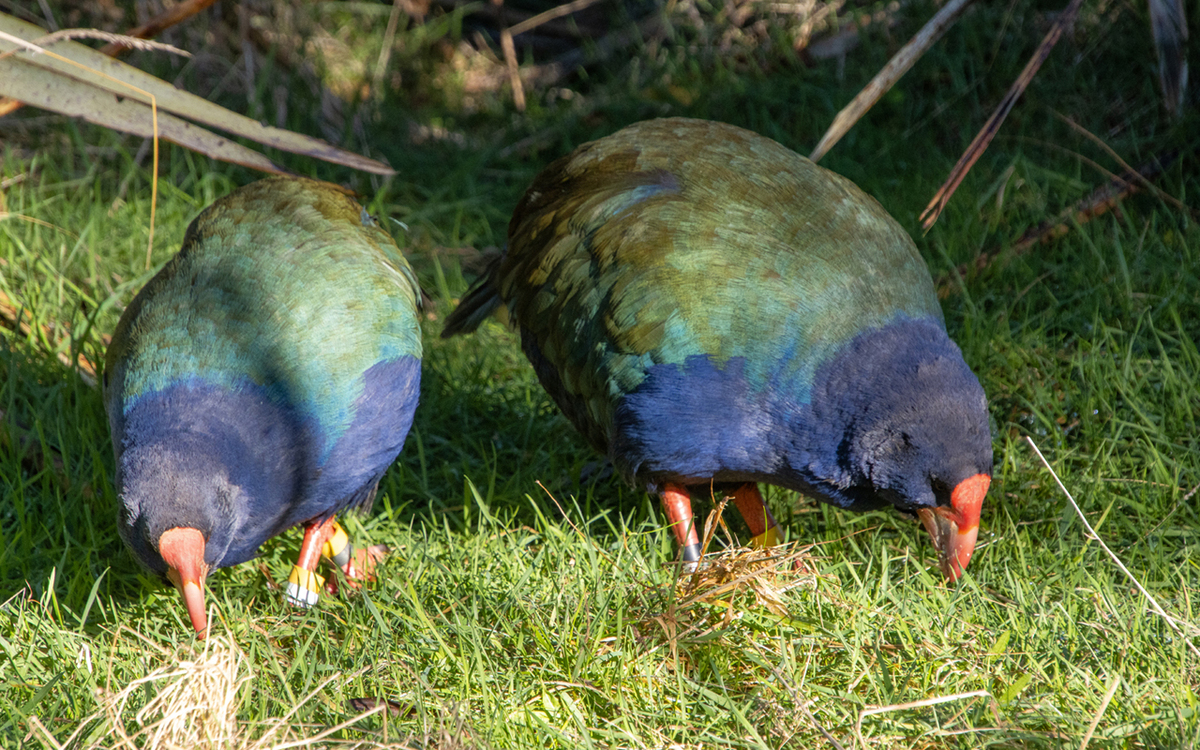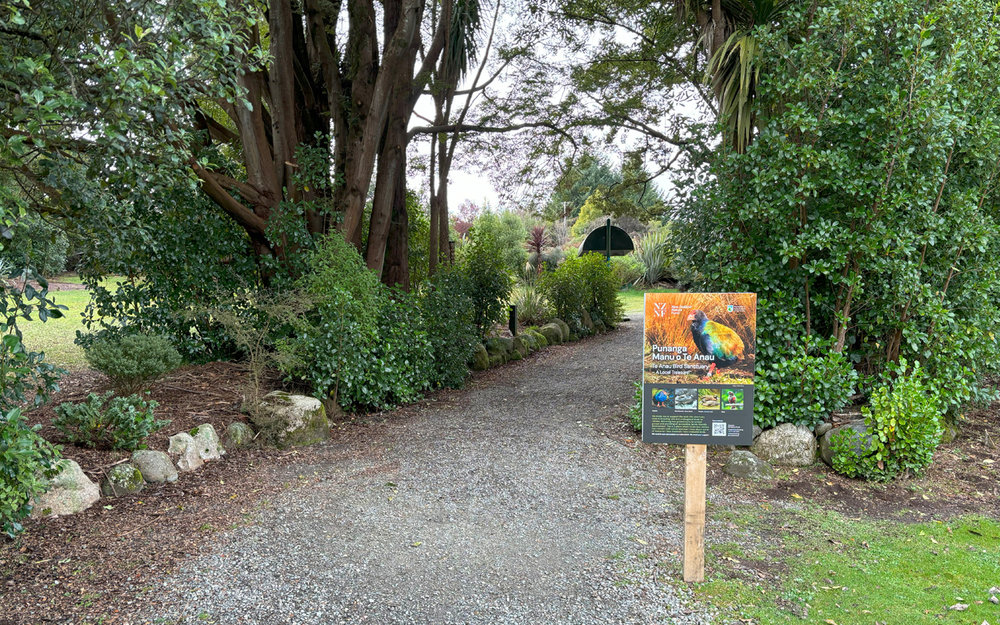Fight on to save the popular Te Anau Bird Sanctuary
Sue Fea © the Southland App
18 June 2025, 3:23 AM
 As the local community rallies, the future of Te Anau's popular Bird Sanctuary and it's takahē (pictured) remains uncertain with a DOC report suggesting other facilities, including Queenstown, could now undertake the facility's captive breeding role. Photo: Liz Newell
As the local community rallies, the future of Te Anau's popular Bird Sanctuary and it's takahē (pictured) remains uncertain with a DOC report suggesting other facilities, including Queenstown, could now undertake the facility's captive breeding role. Photo: Liz NewellThere’s mounting concern about the future of Te Anau’s beloved Bird Sanctuary with DOC plans to pull out, and regional tourism leaders and local iwi now backing local businesses and residents in a bid to ensure the local tourism treasure remains.
Almost 20 people turned out to a public meeting called by concerned Te Anau vet Christina Abramowicz at the weekend, with more still asking to be kept informed.
The Sanctuary receives at least 60,000 visitors a year and is Te Anau’s second most popular tourist attraction.

A recently released Department of Conservation (DOC) report says the Te Anau's popular Bird Sanctuary has suffered from a lack of direction and investment. In February 2025 DOC announced it was withdrawing its management of the facility and would be actively exploring alternatives. Photo: Southland App
However, Great South (regional tourism organisation) and local Te Rūnanga o Ōraka-Aparima have now stepped in.
Great South general manager for regional strategy Bobbi Brown says she’s been asked to begin a consultation process next month (July) on behalf of the local Runanga, Ōraka-Aparima and Southland Fish and Game, which was vested to look after the site.
This will allow everybody involved and the whole Te Anau community to share their views on the future of the site, she says.
“Don’t worry! The park, in its best future form, won’t be lost,” she assures.
“There’s a really good plan in place to ensure that everyone has a say and we’re really excited to make that available next month.”
“The park is an incredibly important asset to Te Anau and all options should be explored with everybody given the chance for input,” she says.
Through that process all options and opportunities for the future operation of the park will be explored.
DOC, which announced earlier this year that it would be opting out of management of the park, is still going through its own separate process to “work out its involvement in the future of the park”, Brown says.
But Te Rūnanga o Ōraka-Aparima as the mana whenua is really keen to be involved in looking at future options for the park.
“They’ve asked Great South to facilitate a process with the public and others, and Fish and Game are supporting that as owners of the land.”
Brown says the sanctuary provides a “very unique and cool opportunity” for people to view endangered species like takahe close to their natural habitat.
“From our perspective we know it’s a very popular and highly valued experience, up there on people’s list of things to do. They love it. We even get feedback from visitors saying if there had been more of a guided experience, they’d have paid more to do that and could we provide it,” Brown says.
Oraka Aparima recognises its “special taonga for the birds” and wants to be involved in future possibilities, she says.
Delighted at this news, Abramowicz says there’s been particular concern about the future of the Sanctuary’s four breeding takahe, with a recent DOC review of the park stating that “other facilities, including in Queenstown, could undertake the captive breeding role”.
DOC released the document to her, but she was surprised it wasn’t released publicly or online so she called Saturday’s public meeting to ensure people were aware.

The Te Anau Bird Sanctuary is home to a number of native species including four adult South Island takahē, two kōwhiowhio/blue duck (pictured), four pāteke/brown teal and four Antipodes Island kākāriki and an itinerant number of waterfowl. Photo: Liz Newell
“The takahē has such a strong historic connection to Te Anau because they were rediscovered here in Fiordland by Dr Geoffrey Orbell in 1948,” she says.
“You can see the Murchison Mountains where he discovered them while standing beside our takahe enclosure at the Sanctuary,” Abramowicz says.
“It’s vital that they stay here. The idea that Queenstown can be comparable to Te Anau for takahe is just so wrong,” she says.
Operations manager of Queenstown’s very successful Kiwi Park, Ant Wilkins says they empathise and recognise this is a tough situation.
“We recognise ourselves the importance of being advocates for species in our local environment and championing them, and with takahe rediscovered just across the water from the Te Anau Sanctuary, we acknowledge the significance of takahe for the Te Anau community,” Wilkins says.
“That’s how we feel about our new kea enclosure. We can look out at The Remarkables from it and know that’s where they came from.”
Everyone from Te Anau parents and teachers to tourism operators have voiced their concerns with the Sanctuary one of Te Anau’s most popular tourist and family attractions.
It’s free to visit with $10 adult tours and children free, open 24/7.
It’s also been an integral part of the local schools’ curriculum and outdoor education programmes, and ‘Orbell the Takahe’ is the Te Anau School mascot.
“Our tourism operators and hoteliers say this Sanctuary is so vital,” Abramowicz says.
“There’s nothing else to do in the evenings and it’s free. To move these beautiful birds would be rather harmful and insulting to our Te Anau operators.”
She says DOC has said they will keep the park open but local residents are most concerned that all the birds stay as part of the attraction.
“Te Anau plays such a critical role in conservation and has been heavily involved in breed-for-release programmes for multiple species,” she says.
There was good support at the meeting to assist in any future operations of the park, with a good number of businesses and tourism operators keen to build on sponsorship that’s already in place, and locals keen to make it all happen.
Fiordland Community Board chairperson Diane Holmes says it’s great that Great South and iwi are getting involved and “may ultimately be part of a positive solution”.

While rundown, Te Anau's Bird Sanctuary still attracts over 60,000 visitors making it one of the most popular attractions in Te Anau. Photo: Southland App
“The park is rundown, and you can see things are deteriorating."
"It’s a well-loved asset with a lot of support from the local community,” she says.
“But decisions need to be made to keep the birds safe."
“I’d very much like to see it saved for a DOC breeding programme and as an educational conservation facility,” Holmes says.
The 60,000 visitors annually has been achieved without any marketing or focus.
“So, I hope a potential fiscally viable solution can been achieved with the right people working together to ensure the park’s future.”
DOC acting operations director Southern South Island, David Agnew says DOC is working closely with Ōraka Aparima and Fish and Game on options for the future of the Sanctuary. “DOC remains committed to the welfare of the birds and acknowledges the importance of Te Punanga Manu to the community.”
No further comment could be obtained this week.
An easy walk from town, the Sanctuary is home to a number of New Zealand native birds including four adult South Island takahē, two kōwhiowhio/blue duck, four pāteke/brown teal and four Antipodes Island kākāriki and an itinerant number of waterfowl.
Its main function under DOC has been as a captive breeding space for kākā, pateke, and whio and the fostering of takahē chicks, as well as some advocacy work.